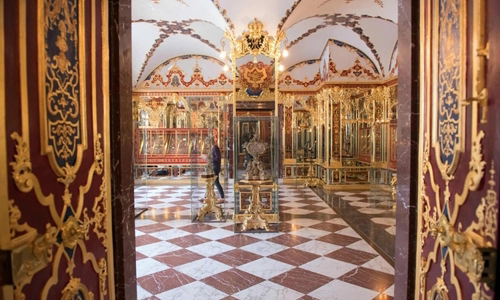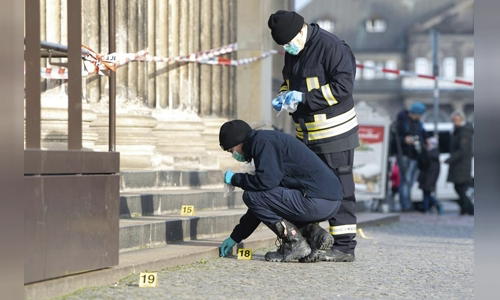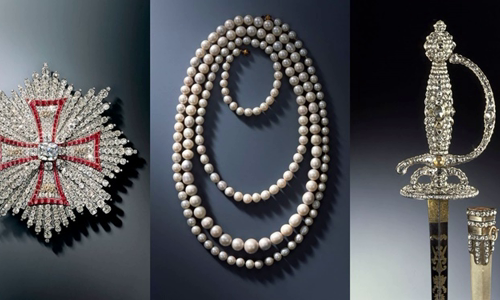Small thieves break the window, break into the German Green Tunnel museum, taking away valuable priceless jewelry in just a few minutes.
German police are investigating the alleged "most catastrophic" in history after nearly a hundred priceless pieces of jewelry were taken from a museum in the Royal Palace in Dresden on November 25.

The jewelry showroom is inside the Green Tunnel museum of the Royal Palace in Dresden Photo: AFP
Authorities described it as a sophisticated burglary where the perpetrators, of unknown numbers, broke through the window to the Grünes Gewölbe (Blue Tunnel), used an ax to smash a glass case and in just a few minute removed at least three priceless jewelry sets from the Baroque period and escaped in an Audi A6.
The government has appointed Epaulette Commission task force to investigate the case. By the end of yesterday, 20 criminals were mobilized to participate in the investigation but could not arrest any suspects.
"This is undoubtedly one of the biggest art treasures in history," said Vivienne Becker, a historian and author of books from London. He added that it is impossible to value the number of jewels stolen by their unique historical value for jewelery. "It's like someone broke into the Louvre and stole the Mona Lisa."
Museum officials also said it was impossible to determine the exact value of the stolen jewelry, including some diamond pins, a pearl string and a sharp knife with a diamond-encrusted hilt. . But the daily newspaper Bild, based in Berlin, assessed "the stolen jewelry is worth around one billion euros (about 1.1 billion USD)".
"We are referring to objects of immeasurable cultural value," said Dirk Syndram, the German art historian, director of the Blue Tunnel museum.
The description from the police along with security video helped to sketch almost in detail the way the burglary took place. Around 5am, thieves broke into the Royal Palace through a window on the side of Sophienstrasse and sneaked into the jewelry room in the Blue Tunnel. In order to break the window, the thief had to break through the iron bars and remove a grille that had been installed in the building since the 1890s. Once inside, they replaced the other grille to no doubt.

Investigators gather evidence at the scene Photo: AP
The museum's unarmed security officers alerted the police when at least two suspects dressed in black, covered with hoods, carrying flashlights and used axes to smash a glass case on a display cabinet made the it crumbles. The first police car arrived at the museum at 5:04 but the criminals escaped from the scene
Authorities believe the group of thieves left the museum by the window and fled on an Audi A6. A vehicle matching the description has been found on fire near the scene. Investigators suspect the burglary was also linked to a technical box fire that occurred at around 4 am as a source of power to the area was cut off, causing the museum's alarm system to be disabled.
Security sources said thieves had to be very small to get through the window hole. Images extracted from surveillance cameras also show the stature of the thieves quite small.
The value of works of art has skyrocketed, and security holes in museums are attracting a new generation of art thieves. Lots of people even conduct bold robberies in the middle of the day, according to the International Museum Council, a non-profit organization representing at least 1,900 museums and galleries around the world.
Last week, a thief took two paintings of the famous artist Rembrandt van Rijn from the Dulwich gallery in London, England, but was discovered while fleeing. He sprayed tear gas at a police officer, escaping successfully but leaving two works of art.
When the international police agency Interpol published an online database of stolen artifacts in August, there were 34,000 artifacts on the list.

Three of the stolen artifacts, from left to right, star clasped the Polish White Eagle chest, 177-beaded pearl necklace and a pointed knife with diamond-encrusted hilt. Photo: AP
The burglary at the Green Tunnel museum yesterday was the second most spectacular theft in recent years in Germany. Earlier this year, a German court began trialing four suspects accused of stealing a huge gold coin from the Bode Museum in Berlin in 2017.
The coin, which weighs nearly 100 kg and has an estimated value of US $ 4.1 million, is a commemorative coin from the Royal Canadian Mint and has yet to be recovered.
According to the Denver-based International Cultural Property Organization, about 90% of museum theft is related to people connected to the premises being hacked. They suggested the German authorities should look closely at Royal Palace staff for clues.
The Blue Tunnel Museum is one of Europe's largest treasures of treasure. It consists of 8 galleries decorated with lavish, magnificent, containing collections of artwork, jewelry and rare items King Augustus II of the 18th century Poland.
Historian Vivienne Becker said the collection at the Blue Tunnel Museum is unique in the world, containing unique jewelry from the 18th century, a time when European artisans were just beginning to use needles. outline in high-end art crafting.
"There is nothing in the world like that," she emphasized. "They are the symbol of the greatest achievement of the people at that time. They are more than jewelry."



 EmilyYoung
EmilyYoung








